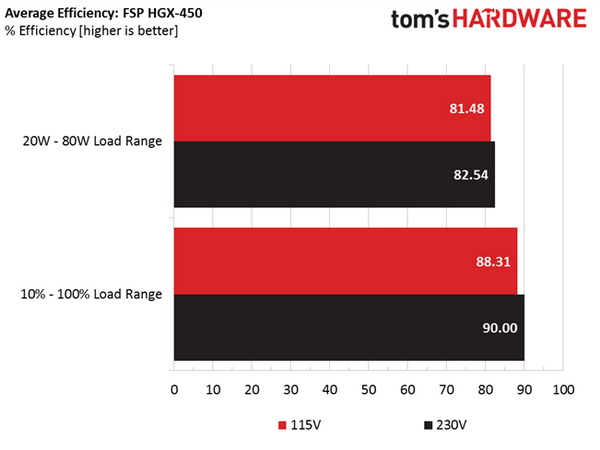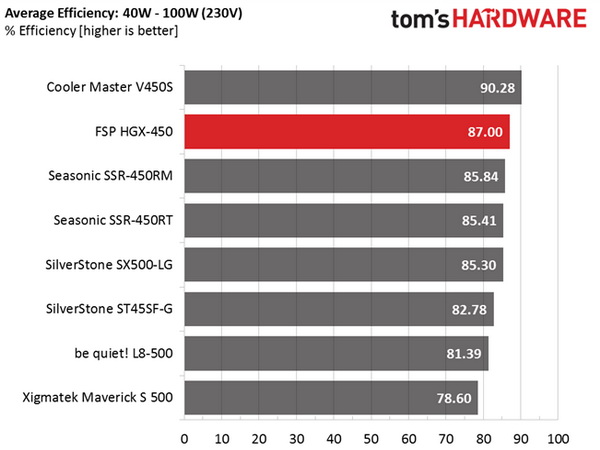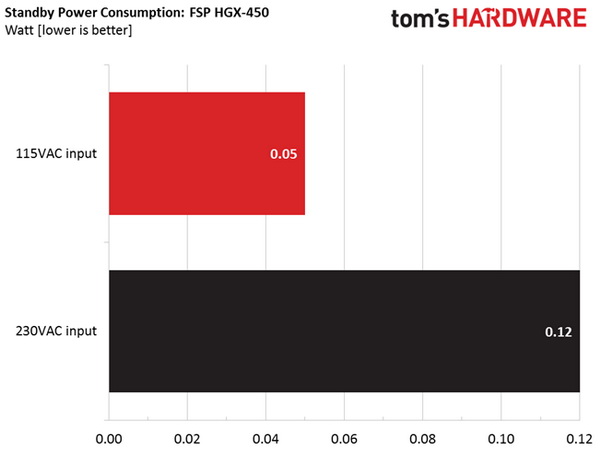FSP Hydro X 450 Power Supply Review
After the Hydro G series, FSP decided to release a more affordable power supply called the Hydro X, which targets systems with lower energy needs. This PSU line consists of three units, and in this review we're testing the entry-level 450W model.
Why you can trust Tom's Hardware
Efficiency, Temperature And Noise
Efficiency
Our efficiency testing procedure is detailed here.
Using the results from the previous page, we plotted a chart showing the Hydro X 450's efficiency at low loads, and loads from 10 to 110 percent of the PSU's maximum-rated capacity.




The HGX450 is the second-most efficient PSU in this category. It loses only to Cooler Master's V450S, which performs phenomenally, especially under light loads. This new FSP platform is also efficient, and if its price drops to more realistic levels, it will be a good choice in the low wattage category.
Efficiency At Low Loads
In the following tests, we measure the efficiency of FSP's Hydro X 450 at loads significantly lower than 10 percent of its maximum capacity (the lowest load the 80 PLUS standard measures). The loads we dialed were 20, 40, 60 and 80W. This is important for representing when a PC is idle, with power-saving features turned on.
| Test # | 12V | 5V | 3.3V | 5VSB | DC/AC (Watts) | Efficiency | Fan Speed (RPM) | Fan Noise | PF/AC Volts |
|---|---|---|---|---|---|---|---|---|---|
| 1 | 1.211A | 0.491A | 0.472A | 0.195A | 19.66 | 72.07% | 695 | 26.2 dB(A) | 0.892 |
| 12.043V | 5.059V | 3.378V | 5.097V | 27.28 | 115.0V | ||||
| 2 | 2.450A | 0.981A | 0.976A | 0.391A | 39.75 | 81.72% | 695 | 26.2 dB(A) | 0.950 |
| 12.046V | 5.052V | 3.375V | 5.086V | 48.64 | 115.1V | ||||
| 3 | 3.689A | 1.475A | 1.479A | 5.074A | 59.83 | 85.14% | 695 | 26.2 dB(A) | 0.970 |
| 12.038V | 5.043V | 3.373V | 5.074V | 70.27 | 115.1V | ||||
| 4 | 4.920A | 1.983A | 1.955A | 0.785A | 79.74 | 87.01% | 695 | 26.2 dB(A) | 0.980 |
| 12.030V | 5.035V | 3.370V | 5.067V | 91.65 | 115.1V |
Under light loads, efficiency is very high. Even with only 20W of load it easily passes the 70% mark. Efficiency exceeds 80% in the rest of the tests, and during the last one it peaks at 87%. As we already mentioned, only the V450S manages to beat FSP's HGX450 here.
5VSB Efficiency
The ATX specification states that 5VSB standby supply efficiency should be as high as possible, recommending 50 percent or higher with 100mA of load, 60 percent or higher with 250mA of load and 70 percent or higher with 1A or more of load.
We take four measurements: one each at 100, 250 and 1000mA, and one with the full load the 5VSB rail can handle.
Get Tom's Hardware's best news and in-depth reviews, straight to your inbox.
| Test # | 5VSB | DC/AC (Watts) | Efficiency | PF/AC Volts |
|---|---|---|---|---|
| 1 | 0.101A | 0.52 | 78.79% | 0.091 |
| 5.114V | 0.66 | 115.1V | ||
| 2 | 0.251A | 1.28 | 83.12% | 0.188 |
| 5.108V | 1.54 | 115.1V | ||
| 3 | 1.002A | 5.09 | 85.84% | 0.358 |
| 5.080V | 5.93 | 115.1V | ||
| 4 | 2.501A | 12.58 | 84.37% | 0.432 |
| 5.031V | 14.91 | 115.1V |


FSP claims to enable a highly efficient 5VSB rail thanks to its advanced standby PWM controller, and indeed this is the case. In fact, efficiency is nothing less than amazing in each test, peaking at nearly 86% with 1A of load.
Power Consumption In Idle And Standby
| Mode | 12V | 5V | 3.3V | 5VSB | Watts | PF/AC Volts |
|---|---|---|---|---|---|---|
| Idle | 12.282V | 5.065V | 3.386V | 5.114V | 6.68 | 0.518 |
| 115.1V | ||||||
| Standby | 0.05 | 0.007 | ||||
| 115.1V |


In the table above, you'll find the power consumption and voltage values of all rails (except -12V) when the PSU is idle (powered on, but without any load on its rails), and the power consumption when the PSU is in standby mode (without any load, at 5VSB).
This unit has very low demands in standby mode, meaning that less energy gets wasted.
Fan RPM, Delta Temperature And Output Noise
Our mixed noise testing is described in detail here.
The first chart below illustrates the cooling fan's speed in RPM, and the delta between input and output temperature. The results were obtained at 34 °C (93.2 °F) to 46 °C (114.8 °F) ambient temperature.
The next chart shows the cooling fan's speed (again, in RPM) and output noise. We measured acoustics from one meter away, inside a small, custom-made anechoic chamber with internals completely covered in sound-proofing material (be quiet! Noise Absorber kit). Background noise inside the chamber was below 18 dB(A) during testing, and the results were obtained with the PSU operating at 34 °C (93.2 °F) to 46 °C (114.8 °F) ambient temperature.


The following graph illustrates the fan's output noise over the PSU's entire operating range. The same conditions of the above graph apply to our measurements, though the ambient temperature was between at 28 °C (82.4 °F) to 30 °C (86 °F).
Up to around 315W load, the PSU is inaudible, generating less than 25 dB(A). The noise remains low at higher loads, registering 31-34 dB(A). This is a quiet PSU overall.
Current page: Efficiency, Temperature And Noise
Prev Page Load Regulation, Hold-Up Time And Inrush Current Next Page Cross-Load Tests And Infrared Images
Aris Mpitziopoulos is a contributing editor at Tom's Hardware, covering PSUs.
-
powernod ReplyDo Hydro PSUs work underwater?
Yeah, they have to work underwater in order to camouflage themselves from Corsair's (PSUs) who dominate the water's surface!! :p
Or to pass through the Seasonic wall !!:lol:
ONTOPIC: Decent PSU from FSP, but only just decent!!
-
Aris_Mp it is hard to enter the US markets with Corsair and EVGA throwing one model after the other and in very competitive prices, however more variation is always welcome. If they lower significantly the price tags on these models then their marketing career will be easier.Reply
-
Dark Lord of Tech Hard to penetrate the EVGA lineups with their great prices on the higher end units. These need to be lowered to sell.Reply -
turkey3_scratch Is there any reason the 3.3V rail shows strange behavior when crossloading? Not that it's bad or anything, but in CL1 with heavy load on the 3.3V rail, the voltage is about 0.10V higher than CL2, where the 3.3V rail has minimal load, and voltage is typically higher.Reply -
turkey3_scratch Okay, just finished reading the review. Besides the disappointing transient response of this unit, and the failure to meet hold-up time, this is a good unit. But the price needs to drop to about $60 IMO if it wants to compete well. Currently it's priced the same as the Hydro G 650W, and the Hydro G is a no-brainer choice over this unit.Reply
It also concerns me a bit that the 5V rail voltage goes to 4.79V in your second transient response test at 50% load. This is all around also a bit disappointing, but it's not a very realistic transient load (unlike 12V which happens always while gaming), but I like the Japanese capacitors, the load regulation is fine, the crossload graphs all show good results; sometimes a lot of units screw up on those. It's nice to be able to see those different load patterns, something other reviewers should try to adopt. Ripple was very nice. -
joz ReplyHard to penetrate the EVGA lineups with their great prices on the higher end units. These need to be lowered to sell.
G2 is love, G2 is life. (G2 550W, about...eight of them....) -
basroil FSP almost had an excellent PSU until they screwed up big time on the transient response. Looks like the EVGA G2/ SuperFlower Leadex Gold is still king of the inexpensive PSUsReply -
Flying-Q Please stop referring to quality PSUs with low wattage as 'entry 'level' (in the article subtitle).Reply
Entry Level (adjective)
(of a product) suitable for a beginner or first-time user; basic.
"entry-level computers"
'Entry level' usually implies smaller feature set. In this instance the feature set of each of the models is the same other than the power output. Current generation computers need less power due to greater efficiency inherent in more recent designs of components. -
turkey3_scratch Reply17768395 said:FSP almost had an excellent PSU until they screwed up big time on the transient response. Looks like the EVGA G2/ SuperFlower Leadex Gold is still king of the inexpensive PSUs
I would like other testing sites to start adopting these tests, like Jonnyguru. I wonder how many units that normally pass stuff would fail.
Another funny thing is FSP just wrote a blog about the importance of transient response. :P
But also, a 3.3V transient response just doesn't happen in 2016, probably never will. A 5V one is also less common. -
basroil Reply17769266 said:But also, a 3.3V transient response just doesn't happen in 2016, probably never will. A 5V one is also less common.
ATX loading specs state a 9A transient on 12V (and 5V might have been there). Considering most modern PSUs are 12V only and then DC-DC for 3.3 and 5V, 12V transients are going to end up affecting the 5v and 3.3V lines too.
